Mare Australe quadrangle
|
Map of Mare Australe quadrangle from Mars Orbiter Laser Altimeter (MOLA) data. The highest elevations are red and the lowest are blue. | |
| Coordinates | 75°S 0°W / 75°S -0°ECoordinates: 75°S 0°W / 75°S -0°E |
|---|---|

The Mare Australe quadrangle is one of a series of 30 quadrangle maps of Mars used by the United States Geological Survey (USGS) Astrogeology Research Program. The Mare Australe quadrangle is also referred to as MC-30 (Mars Chart-30).[1] The quadrangle covers all the area of Mars south of 65°, including the South polar ice cap, and its surrounding area. The quadrangle's name derives from an older name for a feature that is now called Planum Australe, a large plain surrounding the polar cap.[2] The Mars polar lander crash landed in this region.[3] [4]
Notable features
Around the southern ice cap is a surface, called the Dorsa Argentea Formation that may be an old ice-rich deposit. It contains a group of sinuous, branched ridges that resembles eskers that form when streams are under glaciers.[5] The formation often contains pits: two major locations are named Cavi Angusti and Cavi Sisyphi. The pits have steep sides and an irregular shape. They are up to 50 km across and 1 km deep.[6]
The quadrangle also contains Angustus Labyrinthus, a formation of intersecting valley or ridges, nicknamed the "Inca City".[7] Researchers were surprised to see parts of the surface having a Swiss-cheese appearance. Also, some areas showed strange spider-shaped forms, which were determined to be caused by carbon dioxide gas blowing dust around at certain times of the year.
Some craters in Mare Australe show gullies. Martian gullies are small, incised networks of narrow channels and their associated downslope sediment deposits, found on the planet of Mars. They are named for their resemblance to terrestrial gullies. First discovered on images from Mars Global Surveyor, they occur on steep slopes, especially on the walls of craters. Usually, each gully has a dendritic alcove at its head, a fan-shaped apron at its base, and a single thread of incised channel linking the two, giving the whole gully an hourglass shape.[8] They are believed to be relatively young because they have few, if any craters. A subclass of gullies is also found cut into the faces of sand dunes which themselves considered to be quite young. On the basis of their form, aspects, positions, and location amongst and apparent interaction with features thought to be rich in water ice, many researchers believed that the processes carving the gullies involve liquid water. However, this remains a topic of active research. As soon as gullies were discovered,[8] researchers began to image many gullies over and over, looking for possible changes. By 2006, some changes were found.[9] Later, with further analysis it was determined that the changes could have occurred by dry granular flows rather than being driven by flowing water.[10][11][12] With continued observations many more changes were found in Gasa Crater and others.[13] With more repeated observations, more and more changes have been found; since the changes occur in the winter and spring, experts are tending to believe that gullies were formed from dry ice. Before-and-after images demonstrated the timing of this activity coincided with seasonal carbon-dioxide frost and temperatures that would not have allowed for liquid water. When dry ice frost changes to a gas, it may lubricate dry material to flow especially on steep slopes.[14][15][16] In some years frost, perhaps as thick as 1 meter.
Freezing of atmosphere
Research based on slight changes in the orbits of spacecraft around Mars over 16 years found that when one hemisphere experiences winter, approximately 3 trillion to 4 trillion tons of carbon dioxide freezes out of the atmosphere onto the northern and southern polar caps. This represents 12 to 16 percent of the mass of the entire Martian atmosphere. These observation support predictions from the Mars Global Reference Atmospheric Model -- 2010.[17] [18]
Spiders
During the winter, much frost accumulates. It freezes out directly onto the surface of the permanent polar cap, which is made of water ice covered with layers of dust and sand. The deposit begins as a layer of dusty CO
2 frost. Over the winter, it recrystalizes and becomes denser. The dust and sand particles caught in the frost slowly sink. By the time temperatures rise in the spring, the frost layer has become a slab of semi-transparent ice about 3 feet thick, lying on a substrate of dark sand and dust. This dark material absorbs light and causes the ice to sublimate (turn directly into a gas) below the surface. Eventually much gas accumulates and becomes pressurized. When it finds a weak spot, the gas escapes and blows out the dust. Speeds can reach 100 miles per hour.[19] Dark channels can sometimes be seen; they are called "spiders."[20][21][22] The surface appears covered with dark spots when this process is occurring.[19][23] These features can be seen in some of the pictures below.
 Star burst Channels caused by escaping gas, as seen by HiRISE. Star burst channels, also called spiders, may be about 500 meters in diameter and 1 meter deep.
Star burst Channels caused by escaping gas, as seen by HiRISE. Star burst channels, also called spiders, may be about 500 meters in diameter and 1 meter deep.- Spider on the second Martian day of spring, as seen by HiRISE.
- Some spider 14 Martian days later, as seen by HiRISE. Notice increased dark fans caused by outgassing of carbon dioxide and dark material.
Defrosting
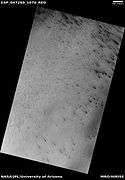 Wide view of defrosting, as seen by HiRISE under HiWish program Gas and dark dust is probably being blown out of ground and then carried by winds toward the Northwest.
Wide view of defrosting, as seen by HiRISE under HiWish program Gas and dark dust is probably being blown out of ground and then carried by winds toward the Northwest. Close view of defrosting, as seen by HiRISE under HiWish program Gas and dark dust is probably being blown out of ground and then carried by winds toward the Northwest. Arrow points to a possible spider formation.
Close view of defrosting, as seen by HiRISE under HiWish program Gas and dark dust is probably being blown out of ground and then carried by winds toward the Northwest. Arrow points to a possible spider formation. Close view of defrosting, as seen by HiRISE under HiWish program Gas and dark dust is probably being blown out of ground and then carried by winds toward the Northwest.
Close view of defrosting, as seen by HiRISE under HiWish program Gas and dark dust is probably being blown out of ground and then carried by winds toward the Northwest. Close view of defrosting, as seen by HiRISE under HiWish program Gas and dark dust is probably being blown out of ground and then carried by winds toward the Northwest.
Close view of defrosting, as seen by HiRISE under HiWish program Gas and dark dust is probably being blown out of ground and then carried by winds toward the Northwest.
 Wide view of spring defrosting. The dark spots are where the ice has disappeared, thus revealing the dark surface beneath the ice. Picture taken with HiRISE under HiWish program
Wide view of spring defrosting. The dark spots are where the ice has disappeared, thus revealing the dark surface beneath the ice. Picture taken with HiRISE under HiWish program Close view of spring defrosting. The dark spots are where the ice has disappeared, thus revealing the dark surface beneath the ice. Picture taken with HiRISE under HiWish program
Close view of spring defrosting. The dark spots are where the ice has disappeared, thus revealing the dark surface beneath the ice. Picture taken with HiRISE under HiWish program
Dorsa Argentea Formation
The Dorsa Argentea Formation (DAF) is thought to be a large system of eskers that were under an ancient ice cap in the south polar region of Mars. This group of ridges extends from 270–100 E and 70–90 S, around the south pole of Mars. It sits under the Late Amazonian South Polar Layered Deposits (SPLD). The amount of these ridges is huge, one study studied seven different ridge systems which contained almost 4,000 ridges that had a total length 51,000 km.[24]
Most eskers are thought to be formed inside ice-walled tunnels by streams which flowed within and under glaciers. After the retaining ice walls melted away, stream deposits remained as long winding ridges.
MARSIS radar data suggest that significant areas of layered, potentially ice-rich parts of the Dorsa Argentea Formation remain today.[25] [26] [27]
 Ridges, believed to be eskers of the Dorsa Argentea Formation, as seen by Mars Global Surveyor wide angle MOC. White arrows point to the ridges.
Ridges, believed to be eskers of the Dorsa Argentea Formation, as seen by Mars Global Surveyor wide angle MOC. White arrows point to the ridges.
Proof for ocean
Strong evidence for a one time ancient ocean was found from data gathered from the north and south poles. In March 2015, a team of scientists published results showing that this region was highly enriched with deuterium, heavy hydrogen, by seven times as much as the Earth. This means that Mars has lost a volume of water 6.5 times what is stored in today's polar caps. The water for a time would have formed an ocean in the low-lying Mare Boreum. The amount of water could have covered the planet about 140 meters, but was probably in an ocean that in places would be almost 1 mile deep.
This international team used ESO’s Very Large Telescope, along with instruments at the W. M. Keck Observatory and the NASA Infrared Telescope Facility, to map out different forms of water in Mars’s atmosphere over a six-year period.[28][29]
Craters
- Map of Mare Australe with major features labeled.
- Hutton Crater Area, as seen by HiRISE. Click on image to see patterned ground.
- Phillips Crater Area, as seen by HiRISE.
 Suess (Martian crater), as seen by CTX camera (on Mars Reconnaissance Orbiter).
Suess (Martian crater), as seen by CTX camera (on Mars Reconnaissance Orbiter). East side of Stoney (Martian crater), as seen by CTX camera (on Mars Reconnaissance Orbiter).
East side of Stoney (Martian crater), as seen by CTX camera (on Mars Reconnaissance Orbiter). Reynolds (crater), as seen by CTX camera (on Mars Reconnaissance Orbiter).
Reynolds (crater), as seen by CTX camera (on Mars Reconnaissance Orbiter).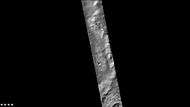 East side of Holmes (crater), as seen by CTX camera (on Mars Reconnaissance Orbiter).
East side of Holmes (crater), as seen by CTX camera (on Mars Reconnaissance Orbiter). Western side of Steno (Martian crater), as seen by CTX camera (on Mars Reconnaissance Orbiter).
Western side of Steno (Martian crater), as seen by CTX camera (on Mars Reconnaissance Orbiter). Pityusa Patera, as seen by HiRISE.
Pityusa Patera, as seen by HiRISE.
Dust devil tracks
- Dust Devil, as shown from HiRISE. Dust devil is moving to the upper left, leaving a dark track to the lower right. The shadow of the dust devil is to the upper left of the dust devil.
 Weinbaum (crater), as seen by CTX camera (on Mars Reconnaissance Orbiter).
Weinbaum (crater), as seen by CTX camera (on Mars Reconnaissance Orbiter).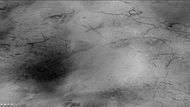 Weinbaum crater region showing dust devil tracks, as seen by CTX camera (on Mars Reconnaissance Orbiter). Field of picture is just outside rim of crater and is an enlargement of the previous image of Weinbaum crater.
Weinbaum crater region showing dust devil tracks, as seen by CTX camera (on Mars Reconnaissance Orbiter). Field of picture is just outside rim of crater and is an enlargement of the previous image of Weinbaum crater. Western side of Mitchel crater (Martian crater), as seen by CTX camera (on Mars Reconnaissance Orbiter).
Western side of Mitchel crater (Martian crater), as seen by CTX camera (on Mars Reconnaissance Orbiter).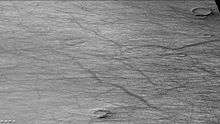 Dust devil tracks in Mitchell crater, as seen by CTX camera (on Mars Reconnaissance Orbiter). Note: this is an enlargement of a previous image of west side of Mitchel crater.
Dust devil tracks in Mitchell crater, as seen by CTX camera (on Mars Reconnaissance Orbiter). Note: this is an enlargement of a previous image of west side of Mitchel crater.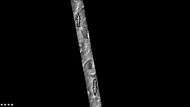 Schmidt (Martian crater), as seen by CTX camera (on Mars Reconnaissance Orbiter). Arrows indicate the north and south rims of crater.
Schmidt (Martian crater), as seen by CTX camera (on Mars Reconnaissance Orbiter). Arrows indicate the north and south rims of crater.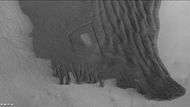 Dunes and dust devil tracks in Schmidt crater, as seen by CTX camera (on Mars Reconnaissance Orbiter). Narrow, dark lines are dust devil tracks. Note: this is an enlargement of the previous image of Schmidt crater.
Dunes and dust devil tracks in Schmidt crater, as seen by CTX camera (on Mars Reconnaissance Orbiter). Narrow, dark lines are dust devil tracks. Note: this is an enlargement of the previous image of Schmidt crater.
Craters showing layers
- Close-up of Layers in wall of McMurdo Crater, as seen by HiRISE.
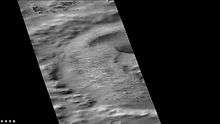 Smith Crater (Martian Crater), as seen by CTX camera (on Mars Reconnaissance Orbiter).
Smith Crater (Martian Crater), as seen by CTX camera (on Mars Reconnaissance Orbiter). Dust devil tracks in Smith Crater, as seen by CTX camera (on Mars Reconnaissance Orbiter). Note: this is an enlargement of the previous image of Smith Crater.
Dust devil tracks in Smith Crater, as seen by CTX camera (on Mars Reconnaissance Orbiter). Note: this is an enlargement of the previous image of Smith Crater. Lau Crater, as seen by CTX camera (on Mars Reconnaissance Orbiter). Curved ridges are probably eskers which formed under glaciers.
Lau Crater, as seen by CTX camera (on Mars Reconnaissance Orbiter). Curved ridges are probably eskers which formed under glaciers.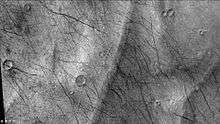 Close up of eskers in Lau Crater, as seen by CTX camera (on Mars Reconnaissance Orbiter). The dark lines are dust devil tracks. Note: this is an enlargement of the previous image of Lau Crater.
Close up of eskers in Lau Crater, as seen by CTX camera (on Mars Reconnaissance Orbiter). The dark lines are dust devil tracks. Note: this is an enlargement of the previous image of Lau Crater. Heaviside Crater (Martian Crater), as seen by CTX camera (on Mars Reconnaissance Orbiter).
Heaviside Crater (Martian Crater), as seen by CTX camera (on Mars Reconnaissance Orbiter). Gullies in a crater that is on the floor of Heaviside Crater, as seen by CTX camera (on Mars Reconnaissance Orbiter). Note: this is an enlargement of the previous image of Heaviside Crater.
Gullies in a crater that is on the floor of Heaviside Crater, as seen by CTX camera (on Mars Reconnaissance Orbiter). Note: this is an enlargement of the previous image of Heaviside Crater. Liais (crater), as seen by CTX camera (on Mars Reconnaissance Orbiter).
Liais (crater), as seen by CTX camera (on Mars Reconnaissance Orbiter). Layers is Liais crater, as seen by CTX camera (on Mars Reconnaissance Orbiter). Note: this is an enlargement of the previous image of Liais crater.
Layers is Liais crater, as seen by CTX camera (on Mars Reconnaissance Orbiter). Note: this is an enlargement of the previous image of Liais crater.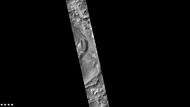 East side of South crater (Martian crater), as seen by CTX camera (on Mars Reconnaissance Orbiter).
East side of South crater (Martian crater), as seen by CTX camera (on Mars Reconnaissance Orbiter). Layers in southern part of mound in South crater, as seen by CTX camera (on Mars Reconnaissance Orbiter). Note: this is an enlargement of the previous image of east side of South crater.
Layers in southern part of mound in South crater, as seen by CTX camera (on Mars Reconnaissance Orbiter). Note: this is an enlargement of the previous image of east side of South crater. Layers just outside the rim of South crater in the form of "Swiss cheese," as seen by CTX camera (on Mars Reconnaissance Orbiter). Note: this is an enlargement of a previous image of east side of South crater.
Layers just outside the rim of South crater in the form of "Swiss cheese," as seen by CTX camera (on Mars Reconnaissance Orbiter). Note: this is an enlargement of a previous image of east side of South crater.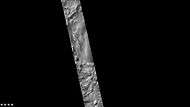 Western side of South crater, as seen by CTX camera (on Mars Reconnaissance Orbiter).
Western side of South crater, as seen by CTX camera (on Mars Reconnaissance Orbiter).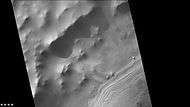 Layers in mound in western side of South crater, as seen by CTX camera (on Mars Reconnaissance Orbiter). Note: this is an enlargement of a previous image of west side of South crater.
Layers in mound in western side of South crater, as seen by CTX camera (on Mars Reconnaissance Orbiter). Note: this is an enlargement of a previous image of west side of South crater. Layers just outside rim of western side of South crater in the form of "Swiss cheese," as seen by CTX camera (on Mars Reconnaissance Orbiter). Note: this is an enlargement of a previous image of west side of South crater.
Layers just outside rim of western side of South crater in the form of "Swiss cheese," as seen by CTX camera (on Mars Reconnaissance Orbiter). Note: this is an enlargement of a previous image of west side of South crater. Rayleigh (Martian crater), as seen by CTX camera (on Mars Reconnaissance Orbiter).
Rayleigh (Martian crater), as seen by CTX camera (on Mars Reconnaissance Orbiter). Layers in Rayleigh crater, as seen by CTX camera (on Mars Reconnaissance Orbiter). Note: this is an enlargement of the previous image of Rayleigh crater.
Layers in Rayleigh crater, as seen by CTX camera (on Mars Reconnaissance Orbiter). Note: this is an enlargement of the previous image of Rayleigh crater.
Craters showing defrosting in spring
 West side of Main crater (Martian crater), as seen by CTX camera (on Mars Reconnaissance Orbiter).
West side of Main crater (Martian crater), as seen by CTX camera (on Mars Reconnaissance Orbiter). Dust trails in Main crater, as seen by CTX camera (on Mars Reconnaissance Orbiter). Arrow indicates wind direction. In the spring, as the temperature rises, dry ice turns into a pressurized gas, and then blows through a weak spot and carries with it dust. If there is a wind, the dust is deposited in an elongated form as in this image.
Dust trails in Main crater, as seen by CTX camera (on Mars Reconnaissance Orbiter). Arrow indicates wind direction. In the spring, as the temperature rises, dry ice turns into a pressurized gas, and then blows through a weak spot and carries with it dust. If there is a wind, the dust is deposited in an elongated form as in this image. Richardson Crater, as seen by CTX camera (on Mars Reconnaissance Orbiter).
Richardson Crater, as seen by CTX camera (on Mars Reconnaissance Orbiter). Dunes and defrosting spots in Richardson Crater, as seen by HiRISE. It is thought that films of liquid water sometimes exist in and around the dark spots.
Dunes and defrosting spots in Richardson Crater, as seen by HiRISE. It is thought that films of liquid water sometimes exist in and around the dark spots. Jeans (Martian crater), as seen by CTX camera (on Mars Reconnaissance Orbiter).
Jeans (Martian crater), as seen by CTX camera (on Mars Reconnaissance Orbiter). Jeans crater showing layers and dark spots from frost disappearing, as seen by CTX camera (on Mars Reconnaissance Orbiter). Note: this is an enlargement of the previous image of Jeans crater.
Jeans crater showing layers and dark spots from frost disappearing, as seen by CTX camera (on Mars Reconnaissance Orbiter). Note: this is an enlargement of the previous image of Jeans crater. Playfair (Martian crater), as seen by CTX camera (on Mars Reconnaissance Orbiter). Dark dots are places where frost has disappeared.
Playfair (Martian crater), as seen by CTX camera (on Mars Reconnaissance Orbiter). Dark dots are places where frost has disappeared. Defrosting going on in Playfair crater, as seen by CTX camera (on Mars Reconnaissance Orbiter). Dark areas are where frost has disappeared thereby showing dark ground. Note: this is an enlargement of the previous image of Playfair crater.
Defrosting going on in Playfair crater, as seen by CTX camera (on Mars Reconnaissance Orbiter). Dark areas are where frost has disappeared thereby showing dark ground. Note: this is an enlargement of the previous image of Playfair crater.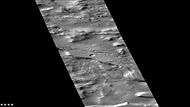 Lyell (Martian crater), as seen by CTX camera (on Mars Reconnaissance Orbiter).
Lyell (Martian crater), as seen by CTX camera (on Mars Reconnaissance Orbiter).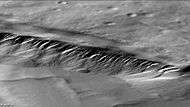 Gullies in Lyell crater, as seen by CTX camera (on Mars Reconnaissance Orbiter). Note: this is an enlargement of the previous image of Lyell crater.
Gullies in Lyell crater, as seen by CTX camera (on Mars Reconnaissance Orbiter). Note: this is an enlargement of the previous image of Lyell crater.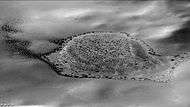 Defrosting taking place in Lyell crater, as seen by CTX camera (on Mars Reconnaissance Orbiter). Dark areas are where frost has disappeared thereby showing dark ground. Note: this is an enlargement of a previous image of Lyell crater.
Defrosting taking place in Lyell crater, as seen by CTX camera (on Mars Reconnaissance Orbiter). Dark areas are where frost has disappeared thereby showing dark ground. Note: this is an enlargement of a previous image of Lyell crater.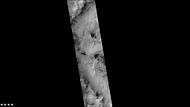 West side of Joly (crater), as seen by CTX camera (on Mars Reconnaissance Orbiter).
West side of Joly (crater), as seen by CTX camera (on Mars Reconnaissance Orbiter). Dark spots and "spiders" in Joly crater, as seen by CTX camera (on Mars Reconnaissance Orbiter). "Spiders" appear as fuzzy spots; they are where dark dust is accumulating in channels below clear slabs of frozen carbon dioxide. Note: this is an enlargement of the previous image of Joly crater.
Dark spots and "spiders" in Joly crater, as seen by CTX camera (on Mars Reconnaissance Orbiter). "Spiders" appear as fuzzy spots; they are where dark dust is accumulating in channels below clear slabs of frozen carbon dioxide. Note: this is an enlargement of the previous image of Joly crater.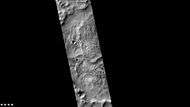 Eskers in Joly crater, as seen by CTX camera (on Mars Reconnaissance Orbiter). Eskers are the ridges in the image; they are formed by streams running under a glacier.
Eskers in Joly crater, as seen by CTX camera (on Mars Reconnaissance Orbiter). Eskers are the ridges in the image; they are formed by streams running under a glacier.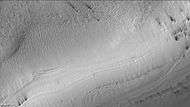 Reynolds crater showing streaks from defrosting, as seen by CTX camera (on Mars Reconnaissance Orbiter). Layers are also visible. Note: this is an enlargement of the previous image of Reynolds crater. Streaks are caused by pressurized carbon dioxide blowing out dust that is blown by the wind into streaks.
Reynolds crater showing streaks from defrosting, as seen by CTX camera (on Mars Reconnaissance Orbiter). Layers are also visible. Note: this is an enlargement of the previous image of Reynolds crater. Streaks are caused by pressurized carbon dioxide blowing out dust that is blown by the wind into streaks. Reynolds crater showing layers and dark spots from defrosting, as seen by CTX camera (on Mars Reconnaissance Orbiter). Area is covered by frost, when the frost disappears the underlying dark ground is exposed. Layers are also visible. Note: this is an enlargement of a previous image of Reynolds crater.
Reynolds crater showing layers and dark spots from defrosting, as seen by CTX camera (on Mars Reconnaissance Orbiter). Area is covered by frost, when the frost disappears the underlying dark ground is exposed. Layers are also visible. Note: this is an enlargement of a previous image of Reynolds crater.
Gallery
 "Inca City" as seen by HiRISE. Light patches are frost deposits.
"Inca City" as seen by HiRISE. Light patches are frost deposits.- Changes in South Pole surface from 1999 to 2001, as seen by Mars Global Surveyor.
- Swiss Cheese-like ice formations as seen by Mars Global Surveyor.
- Swiss Cheese-like ice formations as seen by Mars Global Surveyor showing layers.
- Close-up of Swiss Cheese Terrain, as seen by Mars Global Surveyor.
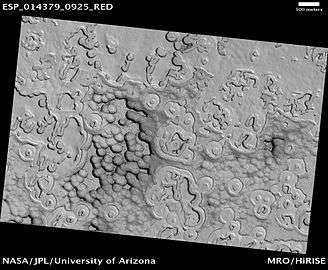 HiRISE view of South Pole Terrain.
HiRISE view of South Pole Terrain.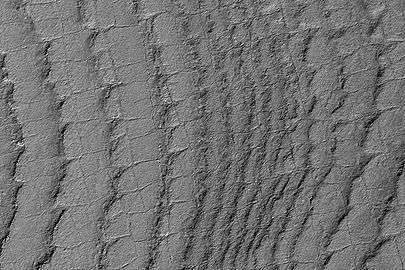 This HiRISE image shows layers running roughly up and down, along with faint polygonal fracturing. Polygonal fractures are mostly rectangular.
This HiRISE image shows layers running roughly up and down, along with faint polygonal fracturing. Polygonal fractures are mostly rectangular.- South Pole layers, as seen by THEMIS.
 Angustus Labyrinthus, as seen by THEMIS.
Angustus Labyrinthus, as seen by THEMIS.
Other Mars quadrangles
Interactive Mars map
See also
References
- ↑ Davies, M.E.; Batson, R.M.; Wu, S.S.C. (1992). "Geodesy and Cartography". In Kieffer, H.H.; Jakosky, B.M.; Snyder, C.W.; et al. Mars. Tucson: University of Arizona Press. ISBN 978-0-8165-1257-7.
- ↑ Patrick Moore and Robin Rees, ed. Patrick Moore's Data Book of Astronomy (Cambridge University Press, 2011), p. 130.
- ↑ http://mars.nasa.gov/msp98/lander/
- ↑ http://www.spaceref.com/news/viewnews.html?id=105
- ↑ Kargel, J.; Strom, R. (1991). "Terrestrial glacial eskers: analogs for martian sinuous ridges" (PDF). LPSC. XXII: 683–684. Bibcode:1991LPI....22..683K.
- ↑ Carr, Michael H. (2006). The Surface of Mars. Cambridge University Press. p. . ISBN 978-0-521-87201-0.
- ↑ Hartmann, W. 2003. A Traveler's Guide to Mars. Workman Publishing. NY NY.
- 1 2 Malin, M., Edgett, K. 2000. Evidence for recent groundwater seepage and surface runoff on Mars. Science 288, 2330–2335.
- ↑ Malin, M., K. Edgett, L. Posiolova, S. McColley, E. Dobrea. 2006. Present-day impact cratering rate and contemporary gully activity on Mars. Science 314, 1573_1577.
- ↑ Kolb, et al. 2010. Investigating gully flow emplacement mechanisms using apex slopes. Icarus 2008, 132-142.
- ↑ McEwen, A. et al. 2007. A closer look at water-related geological activity on Mars. Science 317, 1706-1708.
- ↑ Pelletier, J., et al. 2008. Recent bright gully deposits on Mars wet or dry flow? Geology 36, 211-214.
- ↑ NASA/Jet Propulsion Laboratory. "NASA orbiter finds new gully channel on Mars." ScienceDaily. ScienceDaily, 22 March 2014. www.sciencedaily.com/releases/2014/03/140322094409.htm
- ↑ http://www.jpl.nasa.gov/news/news.php?release=2014-226
- ↑ http://hirise.lpl.arizona.edu/ESP_032078_1420
- ↑ http://www.space.com/26534-mars-gullies-dry-ice.html?cmpid=557882
- ↑ NASA/Goddard Space Flight Center. "New gravity map gives best view yet inside Mars." ScienceDaily. ScienceDaily, 21 March 2016. <www.sciencedaily.com/releases/2016/03/160321154013.htm>.
- ↑ Antonio Genova, Sander Goossens, Frank G. Lemoine, Erwan Mazarico, Gregory A. Neumann, David E. Smith, Maria T. Zuber. Seasonal and static gravity field of Mars from MGS, Mars Odyssey and MRO radio science. Icarus, 2016; 272: 228 DOI: 10.1016/j.icarus.2016.02.05
- 1 2 http://themis.asu.edu/news/gas-jets-spawn-dark-spiders-and-spots-mars-icecap
- ↑ Benson, M. 2012. Planetfall: New Solar System Visions
- ↑ http://www.astrobio.net/topic/solar-system/mars/spiders-invade-mars/
- ↑ Kieffer H, Christensen P, Titus T. 2006 Aug 17. CO2 jets formed by sublimation beneath translucent slab ice in Mars' seasonal south polar ice cap. Nature: 442(7104):793-6.
- ↑ http://www.jpl.nasa.gov/news/news.php?release=2013-034
- ↑ Kress, A., J. Head. 2015. Late Noachian and early Hesperian ridge systems in the south circumpolar Dorsa Argentea Formation, Mars: Evidence for two stages of melting of an extensive late Noachian ice sheet. Planetary and Space Science: 109-110, 1-20
- ↑ Plaut, J., Ivanov, A., Safaeinili, A., Milkovich, S., Picardi, G., Seu, R., Phillips, R. 2007a. Radar sounding of subsurface layers in the South Polar plains of Mars: correlation with the Dorsa Argentea formation. Lunar Planet. Sci. XXXVIII (abstract 2144).
- ↑ Head, J., Marchant, D. 2006. Regional polar glaciation in the hesperian periodof the history of Mars. The South Circumpolar Dorsa Argentea Formation as an Ancient Ice Sheet Remnant. Fourth Mars Polar Science Conference. Davos,Switzerland.
- ↑ Head, J., Marchant, D., Forget, F. 2007. Regional polar glaciation in the hesperian period of the history of Mars: the south circumpolar Dorsa Argentea formation as an ancient ice sheet remnant. Seventh International Conference on Mars. Pasadena, CA (abstract 3115).
- ↑ http://www.sciencedaily.com/releases/2015/03/150305140447.htm
- ↑ . Villanueva, L., Mumma, R. Novak, H. Käufl, P. Hartogh, T. Encrenaz, A. Tokunaga, A. Khayat, M. Smith. Strong water isotopic anomalies in the martian atmosphere: Probing current and ancient reservoirs. Science, 2015 DOI: 10.1126/science.aaa3630
- 1 2 Morton, Oliver (2002). Mapping Mars: Science, Imagination, and the Birth of a World. New York: Picador USA. p. 98. ISBN 0-312-24551-3.
- ↑ "Online Atlas of Mars". Ralphaeschliman.com. Retrieved December 16, 2012.
- ↑ "PIA03467: The MGS MOC Wide Angle Map of Mars". Photojournal. NASA / Jet Propulsion Laboratory. February 16, 2002. Retrieved December 16, 2012.
- ↑ "Online Atlas of Mars". Ralphaeschliman.com. Retrieved December 16, 2012.
- ↑ "PIA03467: The MGS MOC Wide Angle Map of Mars". Photojournal. NASA / Jet Propulsion Laboratory. February 16, 2002. Retrieved December 16, 2012.
External links
| Wikimedia Commons has media related to Mare Australe quadrangle. |
| Quadrangles on Mars | ||||||||||||||||||||||||||||||||||||||||||||||||||||||||||||||||||||||||||||||||||||||||||||||||||||||||||||||||||||||||||||||||||||||||||||||||
|---|---|---|---|---|---|---|---|---|---|---|---|---|---|---|---|---|---|---|---|---|---|---|---|---|---|---|---|---|---|---|---|---|---|---|---|---|---|---|---|---|---|---|---|---|---|---|---|---|---|---|---|---|---|---|---|---|---|---|---|---|---|---|---|---|---|---|---|---|---|---|---|---|---|---|---|---|---|---|---|---|---|---|---|---|---|---|---|---|---|---|---|---|---|---|---|---|---|---|---|---|---|---|---|---|---|---|---|---|---|---|---|---|---|---|---|---|---|---|---|---|---|---|---|---|---|---|---|---|---|---|---|---|---|---|---|---|---|---|---|---|---|---|---|---|
| ||||||||||||||||||||||||||||||||||||||||||||||||||||||||||||||||||||||||||||||||||||||||||||||||||||||||||||||||||||||||||||||||||||||||||||||||

